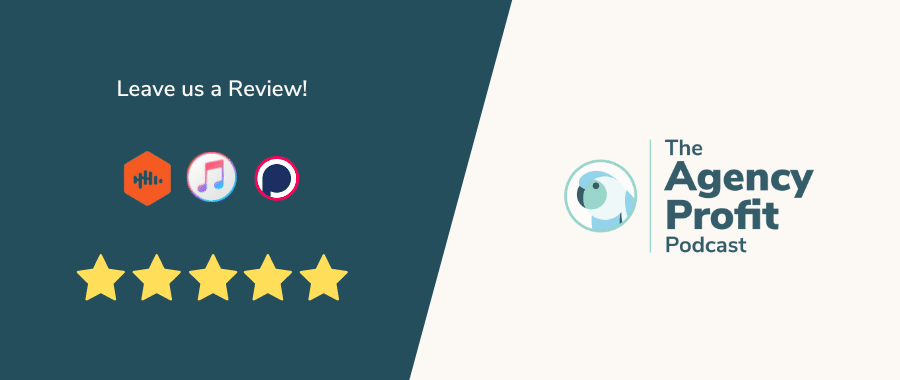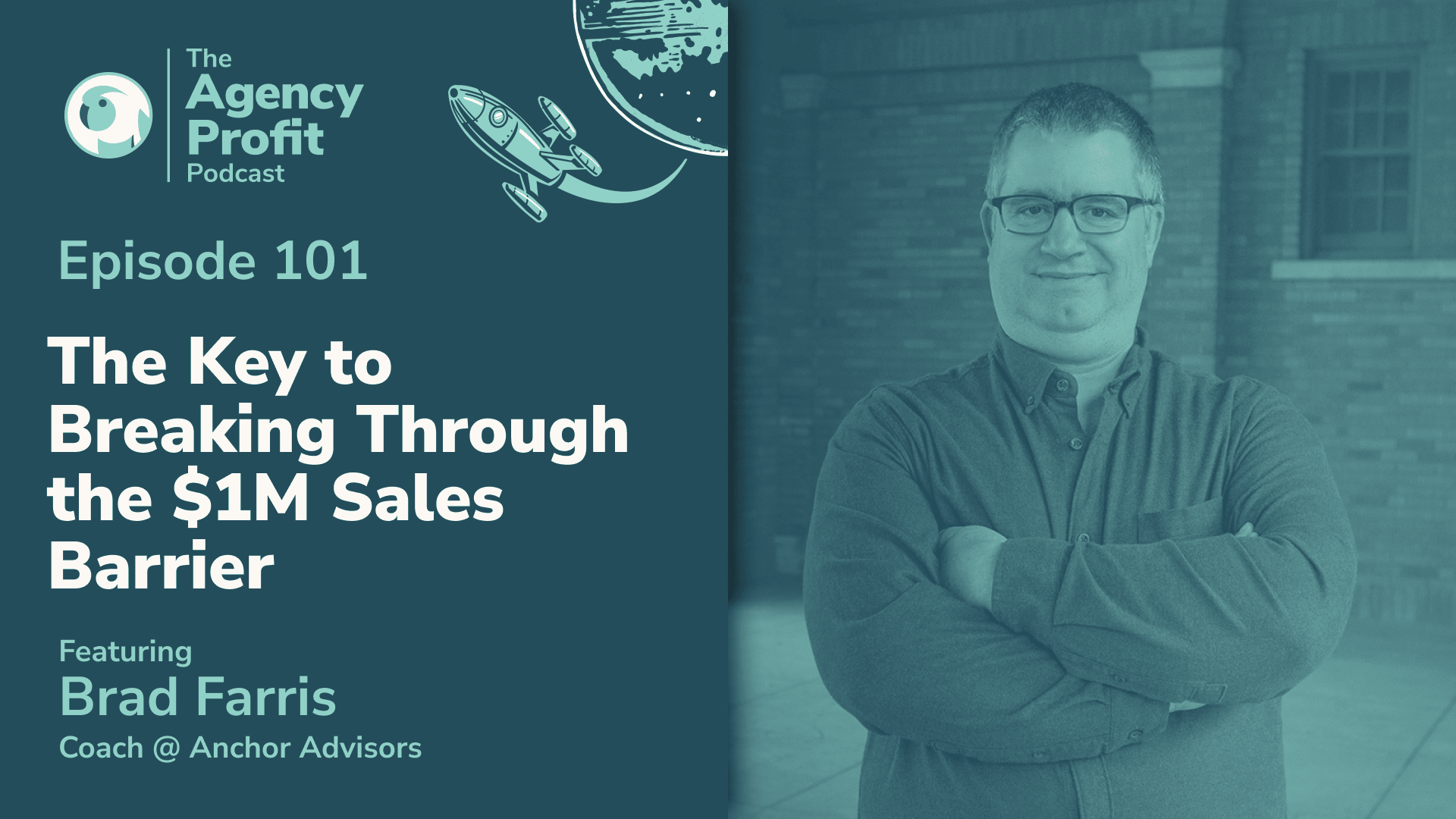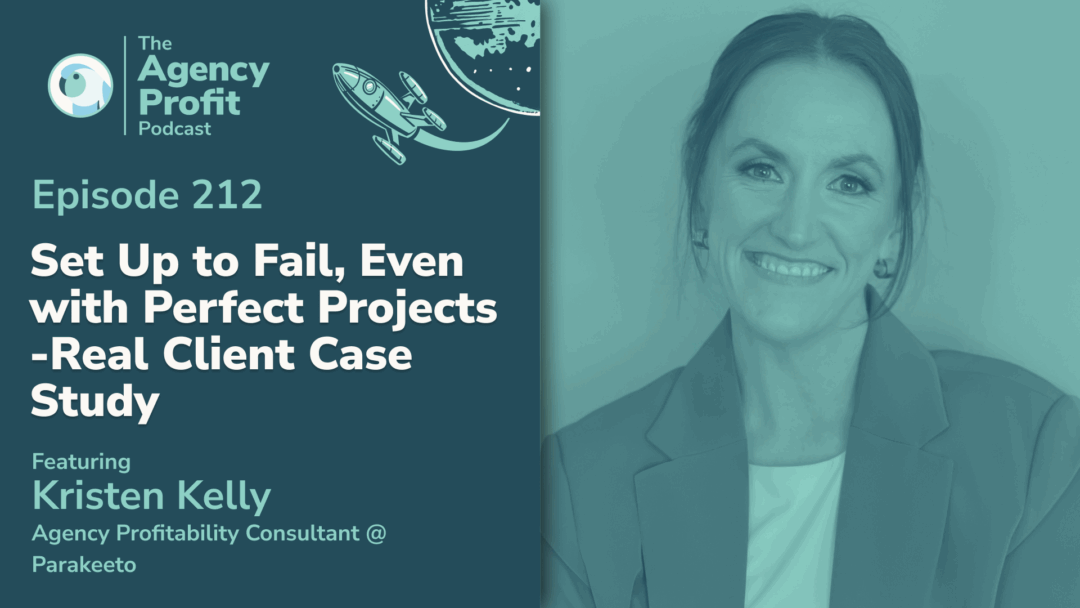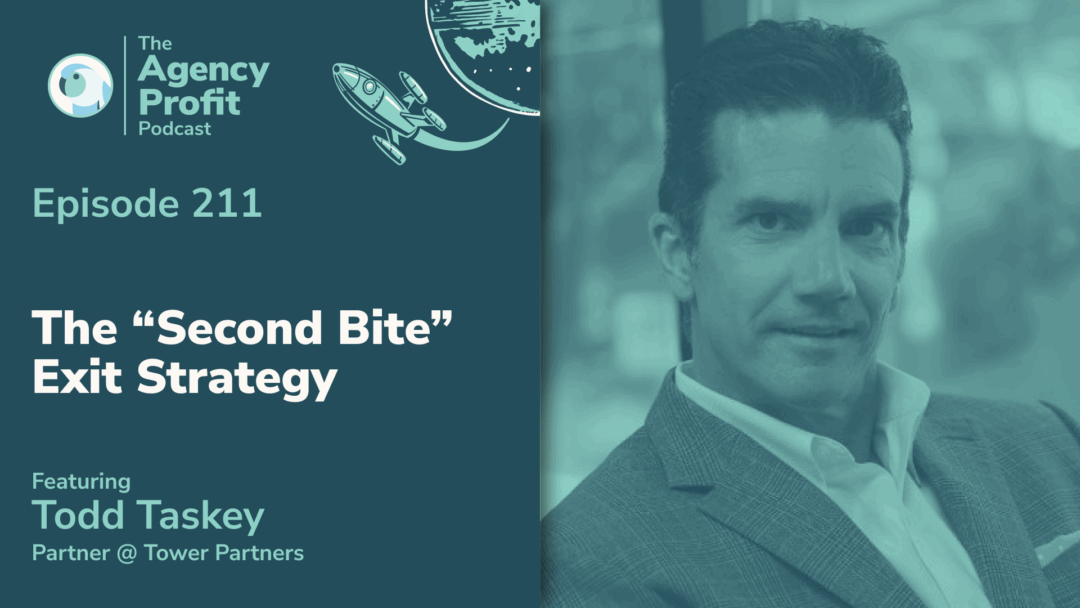This week, Brad Farris of Anchor Advisors chats with Marcel about the key to breaking through the $1M Sales barrier in an agency.
About Brad Farris
Brad is known for helping owners of agencies and expert firms grow through the $1M barrier to be $3M – $5M thriving agencies.
For over 20 years, Brad has worked alongside agency owners to help them to sharpen their focus, raise their prices, and hire better people so that their firm can scale.
In his work with hundreds of agency owners, he’s learned that success is driven less by what you do than who you decide to be, and the biggest hurdle to your agency’s growth is between your ears. Find out more about the work he does at AnchorAdvisors.com
Avid cook, especially Sourdough Bread (before it was trendy). Also love the outdoors, hiking, birding, and national parks
Points of Interest…
- Why $1M is a Hard Barrier to Breach 5:13
- Employee Infrastructure to Break the $1M Mark 6:35
- Importance of Performance Measure to Break $1M 12:55
- Standing Meetings to Help Break $1M Ceiling 18:01
- Progressing Towards $3M to $5M Mark 20:34
Why $1M is a Hard Barrier to Breach
As ever, I’m keen to ask my guest just how he got into the realm of advising businesses. It turns out, Brad found himself progressing from a grounding in manufacturing to solving the plights of billionaires by purchasing founder-led businesses for a billionaire family…
“Cuz the problem with billionaires is their kids think they should make more money than their parents – but they haven’t done anything to add anything to the pie. And so we were buying businesses we thought would grow – to be able to put gas in the jets, feed the horses, and all that kind of stuff.”
Come the year 2000, the M&A market was “super frothy”, leading Brad to go out on his own and instantly fell for the no-fuss agency world, which he describes as “simple, not easy” – especially as most agencies seem to get stuck right around the million dollar mark. But WHY is that the case?
“What makes an agency get to a million dollars? A lot of it is the founder’s own hustle and hard work! Then we create sort of a hub and spoke system where we have team members around us, but we’re smack in the middle. And so what we grow is a bottleneck.”
For most founders, that maxes out about 800,000, 900,000, and usually correlates to 6, 8, 10 people. When you have co-founders partners, sometimes you can get to 1,000,002 or 1,000,005, but the same thing tends to happen.
Employee Infrastructure to Break $1M Mark
So, what is the key to getting the right infrastructure in place in order to pass that million-dollar mark? And, let’s be frank, the growth in between these plateaus tends to be very quick – which is by no means accidental. Neither is the necessary realization that you, as the founder, need to remove yourself from the service delivery.
“That can be kind of an existential moment for people. Like, ‘Wait a minute, I’m the guy, this is what I do!’ Clients may be used to buying from you and seeing your face show up, but that is the primary thing that needs to change, is that you need to get out of the service delivery.”
There’s an important psychological aspect to this. I call it like the founder-led sales hand break, where there is a very challenging psychological barrier that comes with it – which you’re not always aware of. For example, I sell a lot worse when we’re busy because there is a part of me that does not want to make that sale when I’m still involved in the work… ***For further insight on this, make your way to 8:12 minutes***
At this juncture, I ask Brad if there’s anything else that you need to make sure you do at this stage or is that basically, the big lever is disconnecting yourself from client delivery, to which he responds…
“When you disconnect from client delivery, the temptation is to find someone just like me, right?! Because I’m the only one who can do the job! But you’re not gonna find that person because, if they existed, they’d be running their own agency.”
Fact. Therefore, what you need to do is break the job down into different segments; what are the things that other people can do? In particular, you need to separate out the sales role, management, “the working on the business role”, and “the working in the business role”. If you can get those separate, you can then hire for that working in the business role. *** We discuss this more from 9:43 minutes***
One of the things I like to tell people, who are solo founders that are just starting to grow; even if you are still doing all the work, track your time in terms of the hats that you wear. Perhaps you’re wearing three or four primary ones. That way, when it comes to (finally) buying back your time, you will have clarity on where to prioritize. For instance; “the first thing I should do is buy back the project management time.”
Importance of Performance Measure to Break $1M
One of my observations is – at this stage – there seems to be a glaring lack of even rudimentary systems to measure – be it performance, client satisfaction, profitability, time versus budgets, utilization rates, like the very core KPIs! If there is none of that, this then compounds the tendency for founders to not let go. Why? Because there’s no visibility.
Without visibility, the founder is then forced to go back into the trenches, which can lead to apathy. Then, if that goes on long enough, it creates a misinformed belief system that will hold that founder back from EVER scaling past that $1M point. What has Brad’s experience been around the measurement side of things?
“This is a really deep challenge that extends beyond this transition and into the $3M to $5M company transition. We have those people that need accountability, they need to demonstrate that they’re progressing in their careers and therefore have efficacy. So, they will create measurement systems if you haven’t created one.”
This leads to a form of nascent information system. When you start to pull the data together, it won’t add up. Why? Because people are tracking it in different ways and people are measuring differently because they’re doing it to show their individual progression.
“Initially, you attempt to do that kind of measurement with real ad hoc systems, spreadsheets here and there. You might have a CRM, something like that. As your organization grows – and you get to 20 people or 25 people – those information systems completely fall apart. You have to start adopting a more unified information system.”
The sooner you have everyone looking at the same set of data within your agency development, the better. Now I’m not suggesting everyone goes out and adopts a big agency management tool, however, to the extent that you can – do sent about centralizing on how you measure your success for each role within your organization. Even if it is just a spreadsheet to start with; you all must agree that that is THE spreadsheet.
“Like a pilot that’s flying on instruments; you must be able to trust the numbers that are coming out of your system. If they’re ad hoc, then it gets pretty dicey!”
***Tune into us from 16:16 minutes for more on the merits of utilization!***
Standing Meetings to Help Break the $1M Ceiling
So, let’s say you have an array of regular weekly/monthly standing meetings – be it production, or BizDev – whereby you’re coordinating people’s activity. Now, if you’re running said meetings via a system (*ahems* such as Parakeeto) and looking through each department’s most up-to-date findings, it focuses everyone involved on the same set of facts.
“If someone comes to you and says, ‘Oh, but I just didn’t update that,’ you can respond with – ‘Well, this is the one source of truth. If you haven’t updated it, well. I don’t know what to do because THIS is what’s true.’ The more you focus your attention on one system, the more everyone else will submit their information because that’s how they get gold stars, right?”
This is such a fundamental concept for us. Let’s take timesheet compliance and people not following the conventions for example – having this one source regulates a variety of issues because your team sees how their mistakes impact the conversation. It leads you to conclusions that aren’t in line with what actually happened.
“As soon as you pull up a project profitability report and someone says, ‘But all that time wasn’t used there’, you can say ‘Oh, but it was. If that’s where it is in the system, then this is what it is!”
Side note: if you’ve got a process for how you go about defining your scopes for projects, it’s best that you install a regular cadence to review and tweak these numbers based on past performance as time goes on. The Agency Profit Toolkit is a free resource that has meeting templates that you could directly apply to this, among other goodies. Grab your copy below!
Progressing Towards $3M to $5M Mark
You see, that’s the wonderful thing about business; you just get better problems as the levels progress. Apart from protecting the business from indigestion – having the right margins, scope, and processes, while actually ingesting business that is in line with the operating model that you’ve set up – is there anything else Brad thinks we should be keeping in mind before we move on to the next set of problems?!
“One of the things that’s implicit that we didn’t talk about here is that you’re gonna hire a lot of people. If you’re gonna go from an agency of six to an agency of 25 – you’ve probably hired 50 more people to end up at 20 more people, right? And, chances are, you’re going to be terrible at hiring. Thankfully, it’s a skill that some can learn, but it’s also a skill you can buy.”
Give yourself a break and find someone to help you with the recruiting side of things. After all, if you hire someone to do service delivery and they leave, or they’re the wrong person, now you have to do that job AND the one you’ve just created for yourself. It’s super painful, but there are experts who can help, certainly on a contract basis.
In addition to hiring know-how, what other feelers should you have primed as you scale? Well, having context is always a good leveler. For example, Brad states that…
“Only 4% of American businesses are greater than a million dollars. To make it to a million dollars, you’re already in rare air – you’re in the NCAA in a sports context to get to $5M. Only one in 10 businesses that makes it to a million is gonna make it to $5M.”
Sometimes, it’s okay to just be $2M. Perhaps business is ticking along fine and you’re making decent money. However, IF you want to grow beyond that $5M place, the transition will be different from that outlined above. The transition past a million involved you moving from being an individual contributor to being a leader.
There is another layer of management that will come in around $5M. To do that, you also must professionalize your sales process. In other words, while Brad would advise the founder still to be involved in the sales process at $1M, that’s not possible at $5M. Why? Because you need to now be involved in the space OUTSIDE of your agency – spotting trends, potential client issues, industry trajectory, possible future acquisitions…
***For more on this, scoot to Brad’s sage advice from 23:46 minutes***
Key Takeaway
Agencies get stuck at the $1M ceiling for all kinds of reasons, but a lot of it is essentially the founder being a bottleneck. In order to get out of that bottleneck, you need to understand a new management paradigm shift in terms of going from being the person that controls everything, to now empowering and creating accountability among other team members.
Simply put, disconnecting yourself from working IN the business is key, and the only way you can do that is by breaking down your role, bit by bit. Otherwise, if you don’t untangle those things, you’re looking for Superman. And Superman is hard to find, not to mention really expensive.
See more from Brad…
- Brad’s LinkedIn linkedin.com/in/bradfarris/
- AnchorAdvisors.com
Did you learn anything new from this episode? Let us know in the comments below! We have helpful blogs designed to bolster your agency profitability, such as How To Calculate Your Billable Employee Cost-Per-Hour.
Our next installment of #APP, on December 14th, will see Marcel chat with Sharon Toerek for our 102nd edition. Our previous blog – Episode 101 with Corina Ludwig – can be viewed here…
Avid #APP Listener?!
We would be eternally grateful if you could leave us a review…

Agency Profitability Tool Kit
If you’re looking for more resources to help you improve your agency’s profitability, check out the Agency Profitability Tool Kit. It’s full of templates and checklists used when consulting clients. This helps them improve profitability by over 100% in under 60 days.
Fill out the form below for your copy!








0 Comments